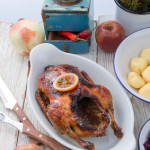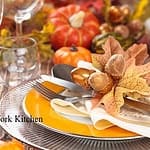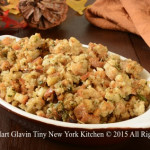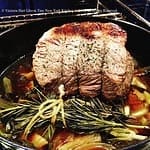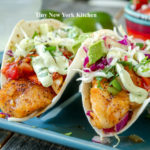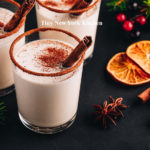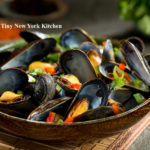Tiny New York Kitchen Wishes You And Your Family A Very Happy Hanukkah!
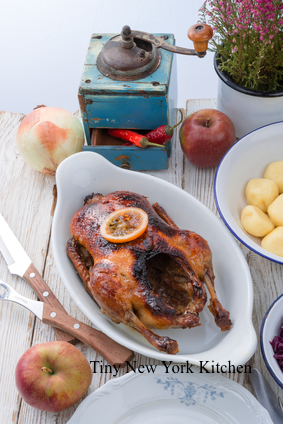
How To Roast A Duck
Roasting a whole duck can seem daunting, but once you’re armed with a little knowledge, a perfectly cooked duck is easily within reach.
Choose the right bird. A Pekin (Long Island) duck is best for roasting whole. It’s ideal to slice, has a sweet flavor, has good fat content, and is widely available.
Score it. There’s a ton of wonderful fat layered between the skin and meat of the duck, which is certainly more than you want to eat. So it’s crucial to score the breasts and legs, slicing through the skin and fat. Make sure to stop before you hit the meat. Scoring allows some of that fat goodness to render out.
Use that rendered fat. Store this priceless liquid gold in the refrigerator or freezer and use it to add flavor to everything from salads to popcorn. Duck fat is a chef’s best friend.
“Work With What You Got!”
© Victoria Hart Glavin Tiny New York Kitchen © 2015 All Rights Reserved
It’s Thanksgiving! Time To Carb Up!
Tiny New York Kitchen Wishes You And Your Families A Very Happy Thanksgiving. We Are Thankful For Our Wonderful Readers & Followers.
Other Meats On The Thanksgiving Table
One of the hallmarks of a feast in seventeenth century England and New England was the presence of several kinds of meat. The menus for the formal dinners of the wealthy might feature more than two-dozen kinds of meat. Even middle class people expected a nice dinner to feature a couple of varieties of meat. Undoubtedly, several meats were served at the 1621 celebration.
For large eighteenth and nineteenth century Thanksgiving gatherings, a single turkey hardly sufficed. Other meats filled out the menu, for example a roast of pork and a substantial chicken pie. In the mid 1800s in Stonington, Connecticut, Grace Denison Wheeler said about her childhood holiday dinner “the big turkey, brown and shining was accompanied by two big pans of chicken pie and roast pork, crisp and brown, clove studded so it had a spicy odor.” Since the holiday fell in the autumn butchering season, it was natural for farm families to have fresh pork on hand. Town dwellers who purchased their meat from butchers could have fresh meat more easily year round, and for them a chicken pie required a good deal less work than for the country dwelling folk, who would have to kill and pluck their own chickens before making a pie.
“Work With What You Got!”
© Victoria Hart Glavin Tiny New York Kitchen © 2015 All Rights Reserved
I’ve been meaning to take a photograph of this fox in the tree for about 3 years. He’s on a winding road to Shakespeare’s Garden and it’s difficult to pull over in order to take a photo. Sunday afternoon I was finally able to pull over. When I stopped the car I stepped out onto a carpet of acorns and was able to get close enough to Mr. Fox to say, “hello there I’ve been wanting to meet you for a few years now.”
This is one of those things that I wish I had invented! A heat barrier for table tops! What a great idea. With a runner of insulated beige linen-polyester, your Chippendale sideboard or farmhouse table will not suffer when it receives piping hot dishes straight from the oven. It measures a generous 4 feet by 13.75 inches, is finished with tassels and comes with magnetic sign cards to identify each dish. The cost is $35. You can find this brilliant runner at http://www.greatusefulstuff.com/entertainment
“Work With What You Got!”
© Victoria Hart Glavin Tiny New York Kitchen © 2015 All Rights Reserved
Dressing & Stuffing
I get asked this question every year about this time, “what’s the difference between dressing and stuffing?” The answer is that if you live north of the Mason-Dixon line, you probably call this side dish, baked inside a turkey, stuffing. If you’re a Southerner, you probably call it dressing. In classic cooking, it’s called forcemeat. Until Victorian times it was just called stuffing and then all of a sudden “stuffing” seemed indecent, and “dressing” was the new name.
For many years roast turkey meant stuffed turkey. Then all of a sudden health concerns arose about whether or not stuffed birds were safe. While these concerns are real, they shouldn’t affect careful cooks who follow food safety practices. Here are a few simple rules to follow while stuffing your bird.
Stuffing should always be cooked to at least 160 degrees in order to kill any potentially harmful bacteria. When the turkey is done, insert the meat thermometer deep into the center of the body cavity to check the temperature of the stuffing. If it isn’t at least 160 degrees then scoop the stuffing out of the cavity and transfer to a casserole dish. Cover and bake at 350 degrees until the stuffing reaches 160 degrees.
Always prepare your stuffing just before filling and roasting the turkey. NEVER stuff a bird the night before roasting as the turkey cavity provides a warm, moist environment that encourages bacterial growth. To save time on Thanksgiving morning, you can prepare stuffing ingredients the night before. Chop the vegetables, toast the nuts, etc. and then store them in zip lock bags in the refrigerator. If you are super pressed for time you may cook, cool, and refrigerate the seasoning meat and vegetables the night before. Reheat them thoroughly in a large-size skillet before adding to the bread or grains.
Stuffing should be warm when placed in the turkey. Cold stuffing may not cook to 160 degrees by the time the turkey is ready.
NEVER mix raw meat or vegetables into a stuffing. All meat and vegetables should be thoroughly cooked.
To serve the stuffing, remove it from the turkey and place in a serving bowl. Do not allow the stuffing or turkey to stand at room temperature for longer than 2 hours. Refrigerate any leftover stuffing separately from the turkey and use within 2 days. Reheat leftover stuffing thoroughly before serving.
“Work With What You Got!”
© Victoria Hart Glavin Tiny New York Kitchen © 2015 All Rights Reserved
Sundays, post summer, are all about Sunday dinners. For me pot roast is the poster child of Sunday dinner because growing up this is what we had. Many of us revert to cooking the foods that we grew up on. There’s something intriguing about food memory and trying to capture the childhood tastes that signify love and warmth. For me, this is Sunday pot roast with roasted winter vegetables.



